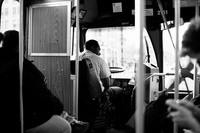Can SmarTrip work for riders with the lowest incomes?

Photo by Erica Wissolik on Flickr.
WMATA’s goal is to get as many riders as possible to use SmarTrip. The approved FY2011 operating budget increases the fare difference between SmarTrip and cash rides, giving an increased incentive to use SmarTrip. But does this hurt riders with lower incomes?
Advocates for riders with low incomes believe that significant barriers to purchasing and using SmarTrip cards continue to exist for these riders.
Potential barriers for riders with low incomes include physical barriers, economic barriers, and situational barriers.
Physical Barriers
The first physical barrier concerns the rider’s ability to get to a location where SmarTrip cards are sold.
I ordered my first SmarTrip card online and purchased replacement cards at the Commuter Store in Rosslyn. In addition, SmarTrip cards are available at various CVS, Giant, and other locations throughout DC, MD, and VA, including Metrorail stations.
Some people are unable to purchase a SmarTrip card online since doing so requires a credit card and not everyone has a credit card. Not everyone who rides the system goes to rail stations or nearby the commuter stores, where SmarTrip cards are sold. And while SmarTrip cards are available for purchase in some CVS and Giant locations, WMATA should expand the number and type of retail locations where SmarTrip cards are sold.
The second physical barrier is one with which I have some personal experience. SmarTrip card readers on buses are not accessible to people who are blind or who have low vision. Due to a visual impairment, I cannot read the balance displayed when I swipe my SmarTrip card. Nor can I read the balance that is displayed when I add money to my card on the vehicle. The truth be told, I simply swipe my card and hope for the best. If the machine (or bus operator) tells me I need to add value to my card, I add value.
This physical barrier is not too much of a problem for me because I always have an extra $5 or so to put on my card. But for riders with very low income AND low vision paying trip-by-trip, this can be a significant barrier and source of frustration. Of course, the solutions involve making the equipment more accessible and, in the meantime, training bus operators to provide the needed assistance to passengers who are blind or who have low vision.
Economic Barriers
The primary economic barrier to purchasing and using a SmarTrip card is the initial cost of the card. The WMATA Board recently voted to reduce the SmarTrip card purchase cost from $5 to $2.50, minimizing this initial financial barrier. WMATA also distributed thousands of SmarTrip cards to social service agencies. Of course, not all people with low-income are clients of social service agencies.
WMATA staff and the WMATA Board have clearly taken action to minimize the financial barrier to purchasing SmarTrip cards. This is commendable. However, there are riders that have such limited financial resources that they can only afford to pay for one or two rides at a time. Once many of these riders actually get SmarTrip cards, they simply load $2 to their SmarTrip cards each time they get on a bus (excluding those times when a transfer applies and they do not need to add any money).
This process is not only burdensome to the rider, but also brings obvious albeit ironic operational implications: it actually slows down the boarding process:
- The rider boards the bus and swipes his/her SmarTrip card.
- The bus operator indicates that there is not enough value on the card.
- The rider indicates he/she wants to add more value.
- The bus operator pushes a button.
- The rider swipes the SmarTrip card again.
- The rider pushes two dollars into the machine.
- The rider swipes the SmarTrip card again to record the added value.
- The rider swipes the SmarTrip card a second time to pay the fare.
In this scenario, using SmarTrip likely takes longer than paying by cash would. Using SmarTrip saves the rider 20¢ per trip and makes free transfers possible. Therefore, the rider willingly endures the inconvenience of adding money each time he/she boards the vehicle to save money. But the unintended consequence is that the dwell time at the stop increases.
Situational Barriers
The final set of barriers to purchasing and using SmarTrip cards relate to a person’s individual circumstances or situation. For some individuals, using SmarTrip might not be practical or realistic. For example, I’ve heard that people with mental health issues are often hesitant to use SmarTrip cards due to fear of losing the cards.
Also, I’ve heard that some undocumented immigrants are fearful of using SmarTrip because they are concerned about agencies knowing their status. Finally, I’ve heard that individuals living in abusive relationships are hesitant, or literally unable, to use SmarTrip cards because they cannot safeguard any of their possessions.
These are just three examples. However, it is important to note that many people living under these circumstances are probably also riders with low incomes.
I am not suggesting that WMATA needs to revolve its fare policy around outlier data or individual scenarios. WMATA should continue to encourage as many people as possible to use SmarTrip cards and should make them as easy as possible to purchase and utilize.
However, WMATA also needs to remember its remaining regular customers who do not use SmarTrip cards or are struggling to use SmarTrip cards. There are social and operational implications to recent fare policy decisions worthy of further conversation.
